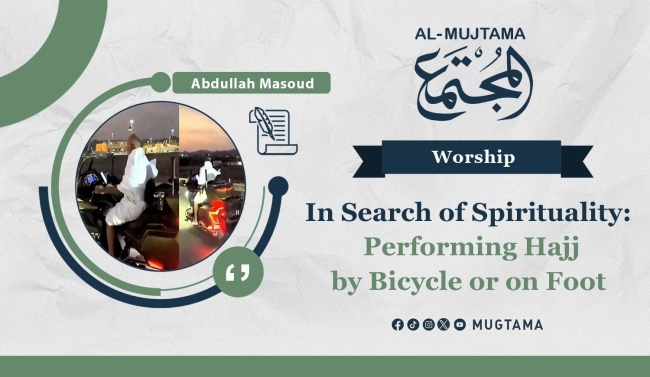In Search of Spirituality: Performing Hajj by Bicycle or on Foot Featured
In an era of high-speed transportation that cuts the journey from any part of the world to Mecca in hours, some prefer to undertake the pilgrimage using a primitive means that takes months and weeks, in an attempt to evoke and experience the spirituality of this sacred journey for as long as possible.
French young man Nabil Al-Nasri may be the latest of these individuals who embarked on a long journey to the Kingdom of Saudi Arabia using a primitive mode of transport that mimics the old pilgrimage routes that crossed deserts on camelback.
Last May, Al-Nasri arrived in Turkey, his eleventh stop, on a bicycle. He started his journey from France in April to perform the Hajj in Saudi Arabia, which might be his thirteenth stop after crossing Iraq.
Al-Nasri, of Moroccan descent, explained that with this arduous journey, he wants to revive the traditional Hajj experience that Muslims followed in the past, according to the Anadolu Agency.
Earlier this year, Syrian refugee residing in Germany, Ghazi Jassem Shahada, also embarked on this journey using the same means.
According to what Shahada's relatives posted on social media and what was reported by various media outlets, he spent 73 days traveling from Germany to Mecca using his bicycle.
However, Shahada, originally from the Syrian city of Homs and aged 53, passed away upon reaching Mecca last February.
Shahada documented his days and moments during this blessed journey through his personal social media accounts, and upon reaching Mecca, he was overtaken by death. He was prayed over in the Grand Mosque instead of praying there.
On Foot
Shahada's journey, in which he used his bicycle, might have been easier than the journey of Adam Mohammed, a British citizen of Iraqi origin, who arrived in Mecca last year coming from London on foot to perform the Hajj rituals.
In a journey that mimics the way of pilgrimage for those who did not own a mount in the early days of Islam, Mohammed reached Saudi Arabia after 10 months and 26 days of walking.
Mohammed covered more than 6,500 kilometers on the journey that started from Britain and crossed through 9 countries: the Netherlands, Germany, the Czech Republic, Hungary, Romania, Bulgaria, Turkey, Syria, and Jordan.
On the reason for undertaking this step, Mohammed said: "There was a strong voice inside me saying that I could go to Mecca by walking all the way from my home. I couldn't ignore this voice; it was burning inside me like a volcano," describing this experience as "the highest and most precious of my wishes."
He explained that upon reaching Mecca, he endured various forms of hardship and difficulties, including harsh and changing weather conditions, just to reach the House of Allah and perform the Hajj rituals.
Returning to Ancient Times
Shahada and Mohammed were not the only ones who embarked on a long pilgrimage journey in a primitive or unconventional way. Many others preceded them, including eight Muslim pilgrims who traveled from London to Mecca on their bicycles.
The journey, documented by Reuters a few years ago, took the amateur cycling team two months, during which they passed through 17 countries across 3 continents from London to Mecca.
According to the team leader, Taher Hasan Akhtar, they traveled through the lands of Britain, France, Germany, Switzerland, Liechtenstein, Austria, Slovenia, Croatia, Bosnia and Herzegovina, Serbia, Kosovo, Bulgaria, Greece, Turkey, Egypt, and Saudi Arabia.
The spiritually rich journey, in anticipation of arriving at the House of Allah which hearts yearn for, saw the participants covering approximately 6,440 kilometers.
On the reason for undertaking the journey in this manner, Taher Mahmood, one of the team members, said: "This journey is for the sake of Allah alone, and the message we want to convey is to be as close as possible to ancient times when people traveled on camels or horses, something that many will never know, not even in their dreams."
Mahmood, who was 43 years old at the time, added that it was a message about earning reward and enduring hardships, with ease coming in the end.
The length of the journey was not the only challenge; it also involved physical challenges, such as climbing the Swiss Alps to an altitude of up to 3,000 meters above sea level, and logistical challenges, like discovering after boarding the ferry from the Egyptian port of Hurghada en route to the Saudi port of Duba that they did not have the appropriate visas for the trip. This forced them to return to the Egyptian capital, Cairo, on a small plane that could not accommodate their bicycles, which they had to leave behind.
The hardships faced by the team, although tough, paled in comparison to the spirituality of the journey. These challenges included being separated from their families, changes in weather from one location to another, and difficulties in finding halal food in several European countries they passed through during their travels.
The Hajj rituals begin on the eighth day of the month of Dhu al-Hijjah, when pilgrims enter the state of Ihram at the specified Miqats. They then proceed to Mecca to perform Tawaf al-Qudum (arrival circumambulation) before heading to Mina to spend the Day of Tarwiyah. They then ascend to Arafat to observe the Day of Arafah.
Afterward, pilgrims throw stones at the largest pillar in the ritual of Rami al-Jamarat at Jamrat al-Aqabah, then return to Mecca for Tawaf al-Ifadah (onrush circumambulation). They go back to Mina to spend the days of Tashreeq and then once more return to Mecca to perform the farewell Tawaf (Farewell circumambulation) before departing the holy places.
-------------------------------------------------------------


